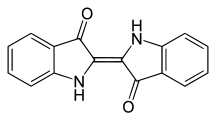Vat dyes
Among the vat dyes to water is one of pigments , for dyeing by reduction in an under alkaline water-soluble conditions leuco be transferred. This reduction is carried out , for example, with hydrosulfite in the presence of sodium hydroxide solution and is also referred to as vatting . After the alkaline solution of the leuco vat dye has been applied to the fiber, it is reoxidized by atmospheric oxygen or other oxidizing agents . The vat dyes are mainly used for cellulose fibers . The dyeings are characterized by excellent fastness properties .
According to the Color Index , the vat dyes are designated as CI Vat Dyes .
Chemical properties
The vat dyes typically have a quinoid system that is converted into the corresponding enols or enolates by reduction :
The following chromophores show this structural element , which can be assigned to carbonyl dyes and pigments:
- indigoid dyes , example: CI Vat Blue 1 (Indigo)
- Anthraquinone dyes , example: CI Vat Green 11
- Naphthalene dyes, example: CI Vat Orange 7
- Perylene dyes, example: CI Vat Red 23
- Pyranthrene dyes, example: CI Vat Yellow 1 (Flavanthron)
The sulfur dyes are also water-insoluble pigments, which are brought into solution by reduction and which are absorbed onto the fiber in the vat form and reoxidize to the pigment. This group of dyes can therefore also be assigned to the vat dyes.
Examples
history
Vat dyes have been known since ancient times. The most important representative was the indigo obtained from woad or the indigo plant . From 1897 indigo was produced synthetically. The range of vat dyes was expanded significantly from 1901 with the invention of indathrene blue (Vat Blue 4) by the BASF chemist René Bohn and the development of the indanthrene range .
See also
Individual evidence
- ↑ Franz Weiss (Ed.): The vat dyes and their use in dyeing and fabric printing . Springer Verlag, Vienna 1953, ISBN 978-3-7091-7827-0 , p. 1 ff . ( limited preview in Google Book search).
- ↑ Klaus Hunger (Ed.): Industrial Dyes: Chemistry, Properties, Applications . WILEY-VCH Verlag, Weinheim 2003, ISBN 978-3-662-01950-4 , p. 1874 ff . ( limited preview in Google Book search).
- ^ Heinrich Zollinger: Color Chemistry: Syntheses, Properties, and Applications of Organic Dyes and Pigments . 3. Edition. WILEY-VCH Verlag, Weinheim 2003, ISBN 3-906390-23-3 , p. 306 ( limited preview in Google Book search).
- ↑ Entry on sulfur dyes. In: Römpp Online . Georg Thieme Verlag, accessed on February 19, 2019.
- ↑ 1901 / Indanthrene dyes. BASF, accessed on February 19, 2019 (German).





